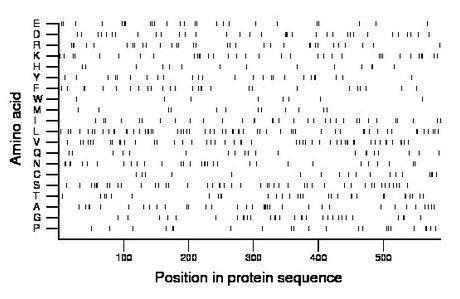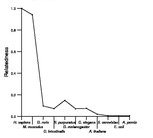
| Name: CCIN | Sequence: fasta or formatted (588aa) | NCBI GI: 169636428 | |
|
Description: calicin
|
Referenced in:
| ||
|
Composition:

Amino acid Percentage Count Longest homopolymer A alanine 5.8 34 3 C cysteine 3.1 18 2 D aspartate 5.8 34 2 E glutamate 4.3 25 2 F phenylalanine 4.6 27 2 G glycine 5.3 31 2 H histidine 2.4 14 1 I isoleucine 5.6 33 2 K lysine 5.8 34 2 L leucine 10.0 59 2 M methionine 2.2 13 1 N asparagine 5.3 31 1 P proline 3.9 23 3 Q glutamine 3.4 20 2 R arginine 5.4 32 2 S serine 7.7 45 2 T threonine 5.6 33 3 V valine 8.3 49 2 W tryptophan 1.4 8 1 Y tyrosine 4.3 25 1 |
Comparative genomics:
Search single species RefSeq proteins at NCBI
Search summary 
Figure data | ||
Related human proteins:Protein Relative score Description Self-match 1.000 calicin KLHL11 0.095 kelch-like 11 ENC1 0.083 ectodermal-neural cortex (with BTB-like domain) [Homo... KLHL29 0.081 PREDICTED: kelch-like 29 (Drosophila) KLHL29 0.081 PREDICTED: kelch repeat and BTB (POZ) domain contai... KLHL29 0.077 PREDICTED: kelch-like 29 (Drosophila) KLHL31 0.077 kelch repeat and BTB (POZ) domain containing 1 [Homo... KLHL38 0.077 kelch-like 38 KLHL5 0.075 kelch-like 5 isoform 3 KLHL5 0.075 kelch-like 5 isoform 1 KLHL21 0.073 kelch-like 21 KLHL20 0.072 kelch-like 20 KLHL25 0.072 BTB/POZ KELCH domain protein KLHL30 0.072 kelch-like 30 KBTBD3 0.070 BTB and kelch domain containing 3 KBTBD3 0.070 BTB and kelch domain containing 3 KLHL10 0.068 kelch-like 10 GAN 0.068 gigaxonin KLHL5 0.066 kelch-like 5 isoform 2 KLHL23 0.066 kelch-like 23 KLHL28 0.066 BTB (POZ) domain containing 5 KLHL4 0.066 kelch-like 4 isoform 1 KLHL4 0.066 kelch-like 4 isoform 2 KLHL18 0.064 kelch-like 18 KLHL32 0.064 kelch-like 32 KBTBD8 0.063 T-cell activation kelch repeat protein KLHL1 0.061 kelch-like 1 protein KLHL7 0.060 kelch-like 7 isoform 1 KLHL12 0.060 kelch-like 12 KLHL17 0.060 kelch-like 17Human BLASTP results (used to prepare the table) | |||
Gene descriptions are from NCBI RefSeq. Search results were obtained with NCBI BLAST and RefSeq entries. When identical proteins are present, the self-match may not be listed first in BLASTP output. In such cases, the table above has been reordered to place it first.
See About the Figures for the scoring system used in the figure above right. The same scoring system was used in the table of BLASTP results.
Guide to the Human Genome
Copyright © 2010 by Stewart Scherer. All rights reserved.
